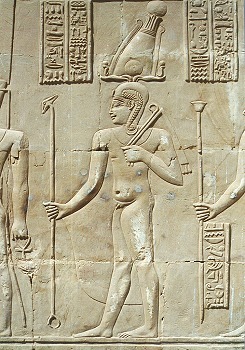
The Egyptian moon god, the son of Amun and Mut with whom he forms the Theban Triad. The most important cult area for Khons was in the Amun complex in the temple of Karnak. The Egyptian word 'khenes', from which the name Khons is derived, means 'to wander'. The god was perceived as a wanderer, an image prompted by the movement of the moon across the sky. This heavenly body was an important determinant of time, and thus Khons became the lord of time. In this capacity he was able to determine how long a man would live, or how many years a king would rule. Khons is connected to many other gods, mainly other moon gods and Thoth in particular. Because in Egyptian theology Amun and the sun god Re were gradually growing closer together, a connection was also created between Khons, the son of Amun, and Shu, the son of the sun god. This resulted in the god Khons-Shu, of whom the funerary texts say that he helps the Ba of the deceased during its journey to heaven. In the New Kingdom, Khons (probably in his capacity as the god of the light of the moon) was even connected with the sun god himself in the form Khons-Re. After all, the moon was regarded as the nocturnal sun. In Karnak Khons was worshipped as 'Neferhotep in Thebes'. As a child god, Khons could also be identified with the child Horus, and as a result he is sometimes represented with the sidelock of youth and standing on crocodiles, an attitude that may be compared with that of Horus on the magical stelae. They were both regarded as gods capable of banishing evil and healing illnesses. It has been suggested that the moon god acquired this function because illnesses were attributed to the influence of the moon. Khons was identified by the Greeks with Herakles, the son of Zeus (the Greek equivalent of Amun), undoubtedly because of Khons's link with Shu as the god who supports the sky. He is depicted in human form with both the new moon and the full moon on his head. Occasionally he is depicted with a falcon's head with sun disk and two tall feathers.